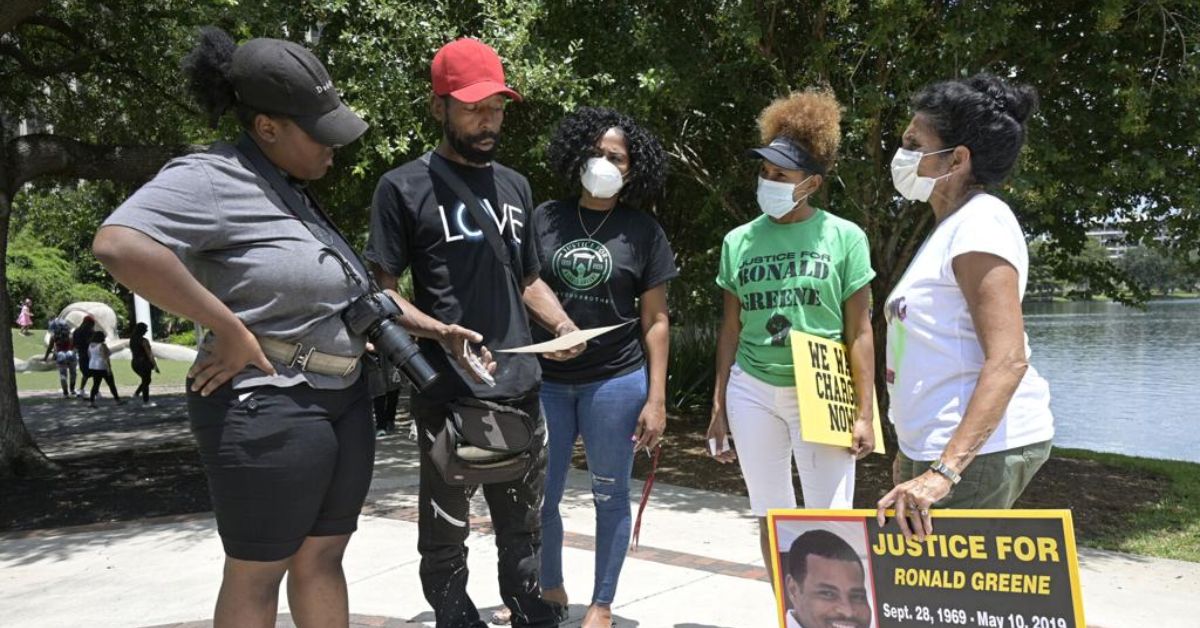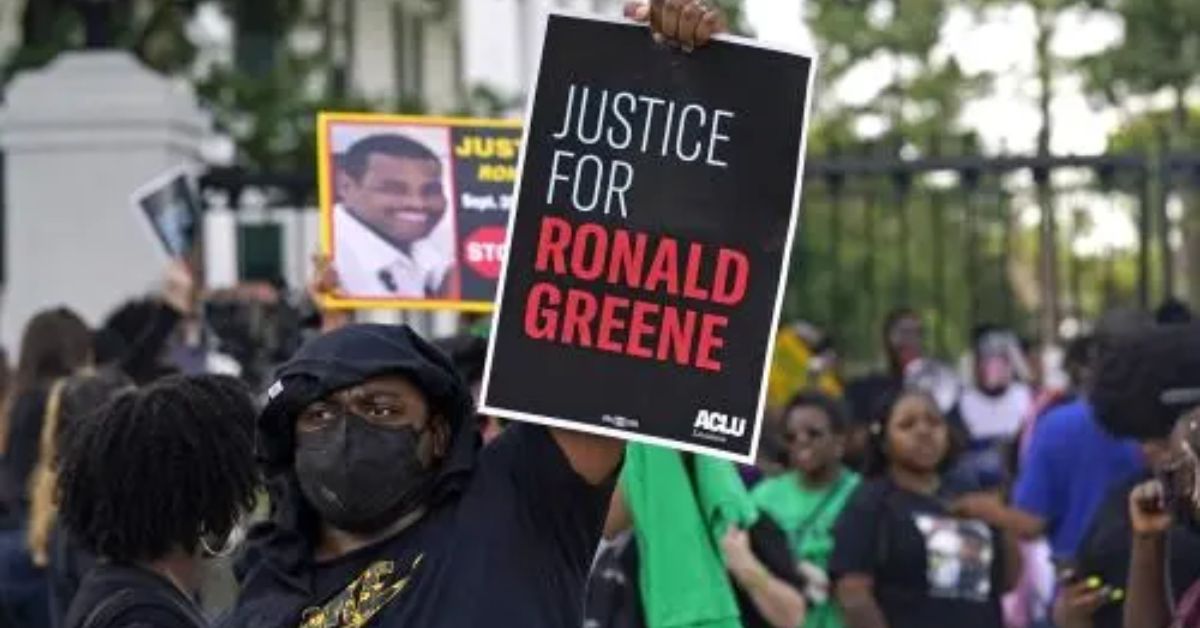Five Louisiana police officers were charged with state crimes on Thursday, ranging from negligent homicide to malfeasance in the 2019 death of Ronald Greene. At first, authorities said that Greene’s death was caused by a car accident, but body-camera footage later showed that white officers beat, stunned, and dragged the Black driver while he screamed, “I’m scared!”
These are the first criminal charges of any kind to come out of Greene’s bloody death on the side of a road in rural northeast Louisiana. The case didn’t get much attention until an Associated Press investigation revealed a cover-up, which led to a close look at the top leaders of the Louisiana State Police, a wide-ranging review of the agency by the U.S. Justice Department, and a legislative inquiry into what Gov. John Bel Edwards knew and when he knew it.
“We’re all happy about the indictments, but will they really pay for what they did?” Greene’s mother, Mona Hardin, has been putting pressure on state and federal investigators for more than three years and has vowed not to bury her son’s ashes until she gets justice. “We’re happy, but we want something to last.”
Master Trooper Kory York is facing the most serious charges from a state grand jury. On the body camera footage, York was seen dragging Greene by his ankle shackles, putting his foot on his back to force him down, and leaving the big man face down in the dirt for more than nine minutes. Experts on the use of force say that this could have made it dangerous for Greene to breathe, and the state police’s own force instructor called what the troopers did “torture and murder.” York was charged with killing someone because of carelessness and ten counts of misbehaving in office.
Others were charged with different types of wrongdoing and obstruction, including a trooper who denied the existence of his body-camera footage and another who exaggerated Greene’s resistance at the scene, a regional state police commander who detectives say put pressure on them not to make an arrest in the case, and a Union Parish sheriff’s deputy who was heard on the video taunting Greene with the words “s— hurts, doesn’t it?”
After the indictments, the head of the state police, Col. Lamar Davis, said, “These actions are unacceptable and have no place in professional public safety services.” He also said that over the past few years, his agency has made changes to “rebuild trust in the communities we serve.”
Union Parish District Attorney John Belton turned in arrest warrants for all five officers. He praised the racially mixed grand jury for listening to the evidence and saying that the people had spoken.

Belton had put off filing state charges for a long time at the request of the U.S. Justice Department, which was looking into a separate crime. But as the years went by, federal prosecutors became less sure they could prove the officers acted “willfully,” which is a key part of the civil rights charges they’re thinking about bringing. This spring, they gave Belton permission to call a state grand jury.
Since last month, this panel has looked at detailed evidence and testimony about how the troopers used force and why they left Greene lying on the ground for several minutes before helping him. A medical expert said that Greene’s death was a murder for the first time in the case.
The federal grand jury investigation is still going on. Last year, it was expanded to look into whether state police leaders blocked justice to protect the troopers. The investigation is still going on, and prosecutors haven’t said when the panel might decide on charges.
Greene’s death on May 10, 2019, was kept secret from the start. Authorities told Greene’s grieving family that the 49-year-old died in a car crash at the end of a high-speed chase near Monroe. However, his family and even a doctor who saw Greene’s badly injured body didn’t believe this story. Still, a coroner’s report said that Greene died in a car accident, and a state police crash report didn’t say anything about troopers using force. It took 462 days for state police to start an internal investigation.
During this time, the body-camera video was kept so secret that it wasn’t shown at Greene’s first autopsy, and officials from Edwards on down repeatedly turned down requests to show it, saying that investigations were still going on.
But last year, the AP got hold of the video and published it, showing what really happened: Greene’s car was surrounded by troopers, who repeatedly shocked him, punched him in the head, dragged him by his chains, and left him lying on the ground for more than nine minutes. Greene would sometimes beg for mercy and cry out, “I’m your brother!” I’m afraid! I’m scared!”
York tells Greene at one point, “Lie on your f——— belly like I told you to!” Christopher Harpin, a deputy for the Union Parish Sheriff’s Office, can be heard taunting, “Yeah, yeah, that hurts, doesn’t it?”
Both York and Harpin’s lawyers said that they think their clients will be found not guilty at trial if the charges aren’t dropped first. When reached by phone, former Trooper Dakota DeMoss, whose body camera caught much of the arrest, said, “You guys always get it wrong.” The lawyer for Lt. John Clary did not answer when asked for a comment in the courthouse. Capt. John Peters of the state police refused to say anything.
As a result of the fallout, the federal government started to look at not only the troopers but also whether the top brass tried to stop justice to protect them.
Investigators have focused on a meeting where detectives say state police commanders told them not to arrest a trooper who hit Greene in the head and later said, “I beat the ever-living f—- out of him.” Most people thought that trooper, Chris Hollingsworth, was the worst of the six officers involved, but he died in a high-speed, single-car accident in 2020, just hours after being told he would be fired for his part in Greene’s arrest.
The AP later found that Greene’s arrest was one of at least a dozen cases in the past 10 years in which state police troopers or their bosses ignored or hid evidence of beatings of mostly Black men, shifted blame, and slowed down efforts to root out wrongdoing. Dozens of current and former troopers said that a culture of impunity, favoritism, and, in some cases, racism led to the beatings.
The U.S. Justice Department used these kinds of reports to start a wide-ranging civil rights investigation into the Louisiana State Police this year. It was the first “pattern or practice” investigation of a state police agency in more than 20 years. The Democratic governor, who is in charge of the state police, is also being looked at closely.
This year, a legislative panel started a “all-levels” investigation into how the state handled the Greene case after the AP said that Edwards knew within hours that the troopers arresting Greene got into a “violent, long-lasting struggle” but stayed mostly quiet for two years while police kept pushing the car crash theory.
Another AP report found that Edwards watched a key body-camera video of Greene’s deadly arrest six months before state prosecutors say they even knew it existed. Neither the governor, his staff, nor the state police acted quickly to get the footage into the hands of those who could bring charges.
Edwards has said over and over that he didn’t do anything to help or hurt the Greene investigation and that the troopers’ actions were both illegal and racist. But he hasn’t testified in front of the legislative panel yet. He said he couldn’t make it to a hearing last month because he was at a ceremony for a new infrastructure project.
Alanah Odoms, the head of the ACLU of Louisiana, said, “Today’s decision is a long overdue first step toward justice for Ronald Greene’s family and accountability for a broken police system.” “Ronald Greene ought to be alive right now.”
Please enjoy our article if you do. Please let us know your thoughts in the comments area below if this is the case. You can find more such news at Journalistpr.com. which you should bookmark as well.

Leave a Reply